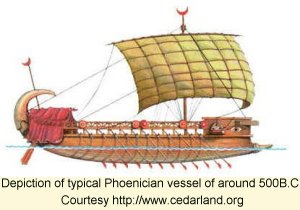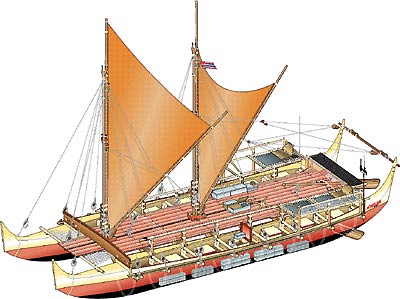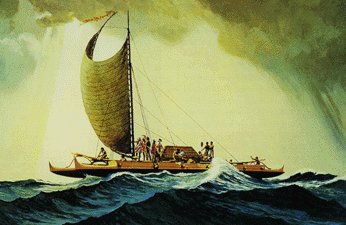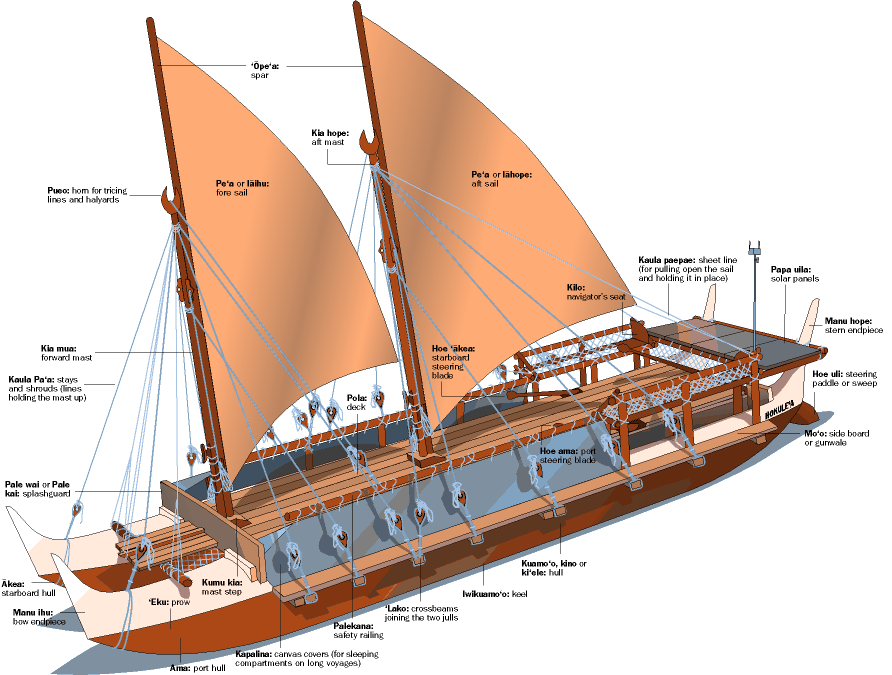


Notice: This is the official website of the All Empires History Community (Reg. 10 Feb 2002)
2 immense Easter Island achievements |
Post Reply 
|
Page <1234> |
| Author | ||||||
Guests 
Guest 
|
 Quote Quote  Reply Reply
 Topic: 2 immense Easter Island achievements Topic: 2 immense Easter Island achievementsPosted: 25-Mar-2008 at 23:48 |
|||||
Where did you get that?
Salas y G�mez didn't have settlers at contact time. I have never heared that Polynesians reached there.
|
||||||
 |
||||||
Guests 
Guest 
|
 Quote Quote  Reply Reply
 Posted: 25-Mar-2008 at 23:51 Posted: 25-Mar-2008 at 23:51 |
|||||
Following the birds... I am not kidding.
And also, seeing the presence of islans far away by "reading" the waves patterns and clowds configurations. It is quite complex the empirical methods polynesian had to determine the presence of far away land. But, I tell you, they weren't just travelling blind in that huge ocean that is the Pacific.
|
||||||
 |
||||||
Guests 
Guest 
|
 Quote Quote  Reply Reply
 Posted: 26-Mar-2008 at 00:39 Posted: 26-Mar-2008 at 00:39 |
|||||
It was not inhabited, but the Eastern Islanders were aware of its existance, evidenced by the fact they had a name for it: Birds Island on the Way to a Far Away Land... |
||||||
 |
||||||
Guests 
Guest 
|
 Quote Quote  Reply Reply
 Posted: 26-Mar-2008 at 12:35 Posted: 26-Mar-2008 at 12:35 |
|||||
|
references, please.
|
||||||
 |
||||||
red clay 
Administrator 

Tomato Master Emeritus Joined: 14-Jan-2006 Online Status: Offline Posts: 10226 |
 Quote Quote  Reply Reply
 Posted: 26-Mar-2008 at 12:55 Posted: 26-Mar-2008 at 12:55 |
|||||
Why? you never do. I'll change that to seldom.
Edited by red clay - 26-Mar-2008 at 12:56 |
||||||
|
"Arguing with someone who hates you or your ideas, is like playing chess with a pigeon. No matter what move you make, your opponent will walk all over the board and scramble the pieces".
Unknown. |
||||||
 |
||||||
red clay 
Administrator 

Tomato Master Emeritus Joined: 14-Jan-2006 Online Status: Offline Posts: 10226 |
 Quote Quote  Reply Reply
 Posted: 26-Mar-2008 at 13:02 Posted: 26-Mar-2008 at 13:02 |
|||||
Odd how you accept voyages of 3-4,000 mi. in the Pacific in open canoes, but not the Atlantic. Particularly if the South Atlantic circulation was followed the longest leg in open water would have only been approx 1,100 mi.
|
||||||
|
"Arguing with someone who hates you or your ideas, is like playing chess with a pigeon. No matter what move you make, your opponent will walk all over the board and scramble the pieces".
Unknown. |
||||||
 |
||||||
Guests 
Guest 
|
 Quote Quote  Reply Reply
 Posted: 26-Mar-2008 at 14:08 Posted: 26-Mar-2008 at 14:08 |
|||||
Nothing odd about it. Austronesian sailors (Indonesian/Javaneses and Polynesians) were far better sailors than the rest of Eurasians and by far. Just compare the history of navigation, and the techniques, of ancient Europeans and Mediterraneans with Austronesians, and you will get convinced.
By the way, Polynesians didn't cross the pacific in canoes, but catamarans. Saying a catamaran is a canoe is like saying a F-1 car is a bike. No way to compare both.
Edited by pinguin - 26-Mar-2008 at 14:09 |
||||||
 |
||||||
Seko 
Emperor 
Spammer Joined: 01-Sep-2004 Online Status: Offline Posts: 8595 |
 Quote Quote  Reply Reply
 Posted: 27-Mar-2008 at 16:17 Posted: 27-Mar-2008 at 16:17 |
|||||
|
Pinguin, how about making reference to your resources regarding the virtues of Austronesian sailors. Share info on the catamarans, etc. Leave the comparisons with other peoples out of your post too. Thanks.
|
||||||
 |
||||||
Guests 
Guest 
|
 Quote Quote  Reply Reply
 Posted: 28-Mar-2008 at 03:23 Posted: 28-Mar-2008 at 03:23 |
|||||
I can't post details right now. However, you could take a look at these sites. I bet you will be surprised by the tecnical details.
 |
||||||
 |
||||||
Styrbiorn 
Caliph 
Joined: 04-Aug-2004 Online Status: Offline Posts: 2810 |
 Quote Quote  Reply Reply
 Posted: 28-Mar-2008 at 10:09 Posted: 28-Mar-2008 at 10:09 |
|||||
|
Catamarans have advantages as well as disadvantages compared to single-hulled ships. Pretending they relate as F1 cars to bikes is simply ridiculous.
|
||||||
 |
||||||
rider 
Tsar 
Suspended Joined: 09-Aug-2004 Online Status: Offline Posts: 4664 |
 Quote Quote  Reply Reply
 Posted: 28-Mar-2008 at 16:09 Posted: 28-Mar-2008 at 16:09 |
|||||
|
Catamarans have just as many disadvantages as advantages - the catamarans we have today sail for half of the year, the other half being too stormy for them. I doubt the Pacific has it otherwise.
|
||||||
 |
||||||
Guests 
Guest 
|
 Quote Quote  Reply Reply
 Posted: 29-Mar-2008 at 02:13 Posted: 29-Mar-2008 at 02:13 |
|||||
Polynesians, Indonesians and other Austronesian people were sailors of high seas in the Pacific when Mediterranean peoples were afraid to lost sight of the coast in that salt lake called Mediterranean
Greek, Phoenician and Roman ships were those big cows, or bikes, if you preffer. In comparison Polynesians were masters of the sea and conquered HALF the world, which is the area the Pacific ocean really covers.
What it is simply ridiculous is downplay the achievements of Polynesians.
|
||||||
 |
||||||
red clay 
Administrator 

Tomato Master Emeritus Joined: 14-Jan-2006 Online Status: Offline Posts: 10226 |
 Quote Quote  Reply Reply
 Posted: 29-Mar-2008 at 04:27 Posted: 29-Mar-2008 at 04:27 |
|||||
Ping, no one is down playing the polynesians. You however have just done the very same.
Worse, your ridiculing 3-4 major cultures at one time. You know exactly what your doing. Stop the games and debate the issue fairly. If you believe the Phoenecians or whoever were unable to sail in an open ocean like the Atlantic or Pacific, then produce credible sources, Not insults.
|
||||||
|
"Arguing with someone who hates you or your ideas, is like playing chess with a pigeon. No matter what move you make, your opponent will walk all over the board and scramble the pieces".
Unknown. |
||||||
 |
||||||
Guests 
Guest 
|
 Quote Quote  Reply Reply
 Posted: 29-Mar-2008 at 04:36 Posted: 29-Mar-2008 at 04:36 |
|||||
What I know about Phoenicians is that they:
(1) make the round trip around Africa. Everyday they started sailing earlier in the morning, but they rested on land at night with theirs boat at the coast. They were excelent sailors but they weren't high seas navigators.
(2) There is no reliable evidence so far about Phoenician presence in the Americas.
|
||||||
 |
||||||
red clay 
Administrator 

Tomato Master Emeritus Joined: 14-Jan-2006 Online Status: Offline Posts: 10226 |
 Quote Quote  Reply Reply
 Posted: 29-Mar-2008 at 04:51 Posted: 29-Mar-2008 at 04:51 |
|||||
Sources for this. What are you backing any of this up with? I don't care which culture or subject, sources. And not the hall of mutt either. Credible sources.
|
||||||
|
"Arguing with someone who hates you or your ideas, is like playing chess with a pigeon. No matter what move you make, your opponent will walk all over the board and scramble the pieces".
Unknown. |
||||||
 |
||||||
Styrbiorn 
Caliph 
Joined: 04-Aug-2004 Online Status: Offline Posts: 2810 |
 Quote Quote  Reply Reply
 Posted: 29-Mar-2008 at 09:28 Posted: 29-Mar-2008 at 09:28 |
|||||
What are you talking about? I was talking about characteristics of ship types, not superiority of one culture over another - why are you constantly interpreting every single thing people say as a 'culture X vs culture Y' comment?. Anyway, the Mediterreanean "cows" as you call them, were warships or merchants, able to carry heavy loads of weaponry or goods. The catamarans would have been less suitable for their purposes, being leisure ships in comparison. The Phoenicians didn't conquer half the world, they conquered a few small dots not covering more than a few percent of the Roman empire. Everyone knows the Polynesians were great sailors, but don't exaggerate. |
||||||
 |
||||||
Guests 
Guest 
|
 Quote Quote  Reply Reply
 Posted: 29-Mar-2008 at 14:57 Posted: 29-Mar-2008 at 14:57 |
|||||
|
Ok. Let's not discuss about culture, then, but go technical.
First, Austronesian people (Of which, Polynesians form part), started theirs epic colonization of the Pacific 5.500 years ago in Taiwan. At the end, they colonized lands that covered more than half the world, from Madagascar to Fiji and Easter Island, and from Hawaii to New Zealand.
 No other people in the world colonized places so widespread by sea before the European Age of Discovery in the 15th century.
Even more, it is known that Indonesians are mentioned with regularity as the best sailors in South-East Asia, with frequent visits to China and Indian, on which they played a role as carriers similar to the Phoenicians in the Mediterranean.
The question is how they managed to do that?
The key was the technology they had for sailing, that basically covers to items:
(1) The design of theirs ships.
(2) The techniques for high-seas navigation.
With respect to the design. It is quite obvious Austronesian people had since very early times an amazing variety of ships. The key to understand theirs technological superiority is to realize all of them have either counterweights or were plainly catamarans.
Just compare. This is a typical Phoenician ship of ancient times:
 Just compare. This is the javanese Borobudur ship, of the kind that brough the Indonesian-Javanese immigrants to Madagascar.
 And a modern replica:
 Just note that the javanese design is oriented to transoceanic travel. Therefore, they don't use hoars, so they have counterweight floating devices, instead. Also pay attention to the fact that these ships have two sails of the "lateen" kind, and have a rudder.
A typical Polynesian catamaran had a design even more impresive. Look at the blueprints
 Rather than just a large canoe, this ship also worked under the counterweight principle, presented a small resistence to the water.
 Hawaii has the best studies on ancient canoes, so all these examples come from there.
A model called Hokule, developed recently in Hawaii.
  So, the ship was there.
Now, let's analize what sailors say about the differences between Catamarans and Monohulls. This article that follows is very revealing. The author is talking about modern catamarans versus monohulls that people uses in pleasure trips.
However, some of his conclusions are very interesting:
catamarans are faster than monohulls.
catamarans don't sink as easy
catamarans can carry more load.
In short, a perfect ship to conquest the Pacific.
We will examine Polynesian navigation techniques later.
CATAMARAN VERSUS MONOHULL � WHICH IS BEST FOR YOU?
by Phillip Berman
COMFORT AT ANCHOR
The great success of catamarans in charter programs over the past decade is due primarily to the fact that catamarans offer enormous advantages over monohulls when the anchor is dropped. These benefits are as follows:
SPEED UNDER SAIL
Because a catamaran does not have to carry a heavy lead keel underneath to stay upright, they are generally faster than a similarly sized monohull � especially off the wind. However, catamarans that carry keels cannot point as high into the wind as a monohull. They will, however, typically arrive at an upwind destination at about the same time because they are moving much faster. They sail a greater distance, but at a much higher speed. A catamaran with daggerboards and good quality sails will point as high as a similar sized monohull. It will also travel at a much higher rate of speed and therefore arrive at upwind destinations sooner. (Note: these are generalizations based on apples to apples comparisons � a performance monohull vs. a performance cat, a cruising cat vs. a cruising monohull, etc.) It is important to note that most of the production catamarans on the market are under-powered charter designs made for trade wind sailing. In light airs many of these designs perform poorly unless larger headsails or a roachier mainsail are added. In winds under 8 knots most catamarans, due to extreme wetted surface drag, are not any faster � and often slower � than similar sized monohulls. COMFORT UNDERWAY
Because a catamaran does not heel it offers far more comfort underway than a monohull. For example:
To overcome the unpleasantness of pounding I believe strongly in catamarans with excellent bridge deck clearance and semi-rounded under carriages that disperse wave action. I also prefer catamarans with few hull protrusions or chines as they increase not only slapping and pounding but magnify hydrodynamic drag. SAFETY
Monohull sailors have for years argued that multihulls are not nearly as safe. I heartily disagree. One of the primary laws of physics is that �Everything in nature seeks its most stable position.� The most stable position for a catamaran is indeed upside down on the top of the ocean. But the most stable position for a monohull is at the bottom of the ocean. A well built and properly designed catamaran is very hard to sink � you must either be run over by a tanker or suffer a massive fire. Multihulls gained a bad reputation in the 60�s and 70�s because most of them were home built, not beamy enough, and poorly designed. But modern Multihulls are very hard to capsize. It really takes a monumental act of bone-headedness to capsize a modern cruising Multihull in winds under 70 knots. If you are so bold as to cruise around far offshore in hurricane zones, well, yes, you are taking a serious risk. But so is a monohull sailor. Fact is, monohulls sink about as often as catamarans capsize, which explains why Lloyd�s insurance policies on cruising cats are nearly the same for cats and monohulls of similar value. (Note: racing mutihulls capsize quite often because they are little more than Hobie Cats on steroids, driven to the edge at all times by thrill seeking racers.) In short, monohull sailors are rescued from liferafts. Multihull sailors are rescued from capsizes. Where would you rather be? Sitting in a small life raft in a storm or sitting securely inside your much larger and more stable upside down multihull? For me, the answer to this is a no brainer. A faster boat is also a safer boat, as the faster boat is exposed to fewer storms. A catamaran that can regularly pull 220 mile days on a passage from Panama to Hawaii will be exposed to far less storm risk than the monohull that has a hard time regularly pulling 175 mile days. With good weather routing information a Multihull can avoid most serious weather and, at worst, place itself on the most favorable position to avoid the brunt of a storm. Since most multihulls can run before a storm between 10 and 15 knots they offer considerably more options and therefore safety than a boat that has difficulty topping out over 9 knots. I would say that a monohull is preferable for serious offshore single-handed sailing because you can hove-to in a howler and sleep it out more easily than you can on a catamaran. A multihull does require very careful seamanship in serious storms. For this reason I believe monohulls are better suited to single handed sailing or voyaging in Northern and Southern latitudes. A super well built monohull will often capsize or even roll in a storm, but they generally pop back up, even if the rig has been swept away. Once a catamaran goes over she stays over. But, here again, she generally stays afloat, offering an excellent place to survive until one is rescued. I also believe that catamarans are superior to monohulls in terms of redundancy. Cruising catamarans generally carry two diesel engines and a diesel generator. An engine failure on a monohull is the end of motoring. Not so on a catamaran. In fact, when motoring, most catamaran sailors only use one engine to conserve on fuel. They use two engines to dock. And a catamaran has two hulls, not one. Should one of the hulls be damaged you still have another one for buoyancy. A hull fracture on a monohull is a far more serious and dangerous thing that it is on a Multihull. MANEUVERABILITY
Because most catamarans have twin engines they are far easier to dock than a single engine monohull. A modern catamaran can do a 360 turn in her own length. A monohull cannot do this. However, a monohull under sail is much more maneuverable and certainly will tack a lot faster than a catamaran. In shallow areas the catamaran is clearly superior to a monohull. Because most cats draw 4 feet or less of water they can anchor in places a monohuller could not even consider. In the Bahamas and the South Pacific the catamaran sailor has a peerless advantage. I often anchor my own cat just a few feet away from a beach, occasionally tying her off to a tree. HAULING, STORAGE AND SLIPPAGE
While catamarans are better at anchor, monohulls have one huge advantage at the dock, marina or shipyard � they are much cheaper to haul and slip and they have a lot more options. Most catamarans must be slipped on end ties due to their beaminess. As such, there are some marinas a catamaran cannot use. Trimarans are even harder to contend with. And, for the most part, the marinas that do take multihulls charge more. The beaminess of multihulls also greatly limits the number of shipyards that can haul them. Most 40 foot and over multihulls must be hauled on a 50 ton travel lift. This not only increases the cost of getting the boat out of the water, but greatly limits the multihullers choice of the shipyards he can use for repair and maintenance. This of course limits one�s shopping power and drives up the price for shipyard services. COST Catamarans, alas, are very costly to build. Builders must create two hulls, a large salon, and finish all of them off with cabinetry. And the rigging and sails of a catamaran must be more stout because the Multihull doesn�t heal and bleech off loads when hit by puffs like a monohull. Monohulls can be bought cheaper new and the buyer of a monohull has a lot more choice of builders. On the used market monohulls are very cheap to buy because the supply presently far outstrips the demand. Such is not the case with catamarans. Used catamaran prices remain quite high and stable, even in our weak economy these past few years. When I am contacted by someone who says they are searching for a cruising multihull under $150,000 I often advise them to buy a monohull. Their choices in a catamaran are very, very limited. Under $100,000 the task is nearly impossible unless one is drawn to very old, one-off models, or older, smaller budget catamarans like the Gemini. It is of course important to remember that if you buy a monohull cheap you will surely also sell her cheap. If you buy a catamaran properly she will hold her value remarkably well for years to come if the present trend toward catamarans continues. I see no reason why it won�t. --------------
In short, Polynesians had a better ship.
Edited by pinguin - 29-Mar-2008 at 15:02 |
||||||
 |
||||||
Styrbiorn 
Caliph 
Joined: 04-Aug-2004 Online Status: Offline Posts: 2810 |
 Quote Quote  Reply Reply
 Posted: 02-Apr-2008 at 13:11 Posted: 02-Apr-2008 at 13:11 |
|||||
No, they didn't. They had ships more suitable for other tasks. The conclusions you have drawn are irrelevant, since they are based on modern pleasure cruisers. They have little to do with a comparison between ancient Mediterrenean galleys and polynesian ships. Catamarans are more stable in the beam-direction, having no tendency to list. On the other hand they may pitchpole, which a monohull never do. In heavy seas monohulls have a great advantage. Catamarans have to ensure the waves doesn't hit from the side to avoid capsizing. To ensure this they need plenty of space (as they indeed do in the Pacific). The polynesian catamarans couldn't take nearly as much goods or soldiers as the Greek galleys. Oars is not a bad thing either as you seem to suggest: in shallow waters with lots of skerries or islands it's necessary to be able to go in all directions in all times. Having a ship without oars in such waters would be really un-intelligent. In any case it's quite pointless to discuss, since it's all again about apples and oranges; if I was to cruise long distances in the Pacific I'd choose the catamaran, if I were to do battle or trade in the Aegean I'd choose the galley 7 days a week. |
||||||
 |
||||||
Guests 
Guest 
|
 Quote Quote  Reply Reply
 Posted: 02-Apr-2008 at 17:38 Posted: 02-Apr-2008 at 17:38 |
|||||
Yes, they did. They had ship more suitable for conquering the Pacific
Nice topic for a thesis.
Yes. I agree on that. Besides, cathamaran are faster, which mean sailors could get very far away from home with the same food.
A small cathamaran fleet could carry everything needed to conquer an island, including chickens, pigs and the tree of bread. They didn't need to carry Spartans from an island to the other in the Mediterranean
You can't cross the Pacific in galleys. Nobody even tried it.
Well, I agree on that. But you have to understand Polynesians conquered the Pacific, not just the mediterranean like Greeks and Roman did. It is another scale of things. They happened almost at the same time, though.
|
||||||
 |
||||||
Styrbiorn 
Caliph 
Joined: 04-Aug-2004 Online Status: Offline Posts: 2810 |
 Quote Quote  Reply Reply
 Posted: 02-Apr-2008 at 18:01 Posted: 02-Apr-2008 at 18:01 |
|||||
That doesn't mean they are overall better; it means they are more suitable.
Indeed, the Romans had a much more difficult task. |
||||||
 |
||||||
Post Reply 
|
Page <1234> |
| Forum Jump | Forum Permissions  You cannot post new topics in this forum You cannot reply to topics in this forum You cannot delete your posts in this forum You cannot edit your posts in this forum You cannot create polls in this forum You cannot vote in polls in this forum |
Bulletin Board Software by Web Wiz Forums® version 9.56a [Free Express Edition]
Copyright ©2001-2009 Web Wiz
This page was generated in 0.078 seconds.
Copyright ©2001-2009 Web Wiz
This page was generated in 0.078 seconds.











 Printable Version
Printable Version Google
Google Delicious
Delicious Digg
Digg StumbleUpon
StumbleUpon Windows Live
Windows Live Yahoo Bookmarks
Yahoo Bookmarks reddit
reddit Facebook
Facebook MySpace
MySpace Newsvine
Newsvine Furl
Furl Topic Options
Topic Options